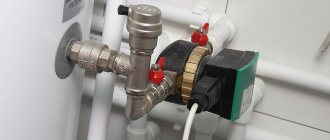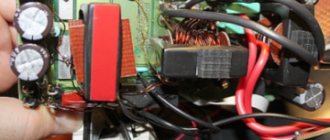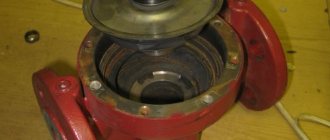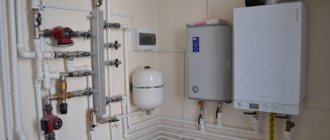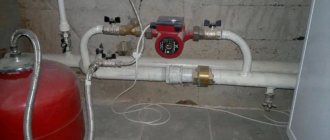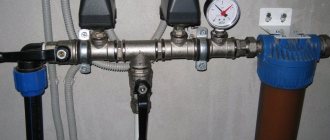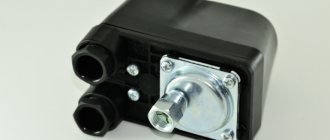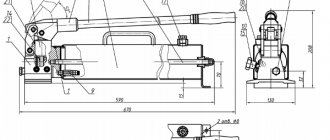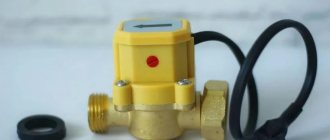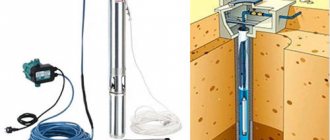From the author: Hello, dear readers! The circulation pump plays a very important role in the heating system of almost any private home. Without this device, the coolant flows through the pipeline at a very low speed, resulting in significant wasted thermal energy losses. The result is an unevenly heated house and the danger of freezing of pipes located in non-residential premises - in the attic, basement, etc.
The circulation device easily prevents the mentioned problems. It increases the speed of the coolant flow, thereby giving the liquid the opportunity to quickly run along the route and deliver the required amount of heat to all radiators and other similar equipment. Naturally, to perform this function efficiently, the device must work flawlessly. That's why every homeowner should know how to test a heating circulation pump.
As you know, timely diagnostics can detect a malfunction even in the early stages of development, so a preventive inspection will help protect the device from possible serious damage. The nice thing is that performing the check will not take much of your time and effort, and almost any owner can handle the necessary repairs. Of course, to do this you need to have some information - and you can get it from today's article.
How to check the heating circulation pump for serviceability
You can check in the following ways.
Ease of inclusion
To examine the performance of the equipment, it is recommended to check whether it is easy to turn on. After seasonal downtime, the condition of the unit must be checked.
To do this, it is recommended that after switching on, listen to the sounds that the equipment makes during operation. If there is no damage, the unit operates quietly .
If you hear various sounds, you will have to check the contamination of parts , the amount of water in the system, etc.
Presence of noise during operation
If the circular pump makes noise, it requires diagnostics or complete replacement. Sounds occur due to malfunction of the rotor or impeller , which can render the entire heating system unusable.
Sometimes noise occurs due to voltage drop . This happens due to imbalance and synchronization, which leads to uneven movement of the coolant.
Attention! Diagnostics are carried out only by a specialist .
If operation is stable, but the device still makes noise, it is recommended to check:
- Is the operating power of the unit equal to the initial values? If the calculations are similar, then the coolant moves too quickly or slowly, which leads to noise.
- Is the motor rotor in a horizontal position?
Bearing operation
Bearings wear out and vibrate heavily.
They are responsible for rotating the impeller, so if the part is no longer suitable for use, it needs to be replaced.
Also, bearings sometimes become damaged and make knocking or squeaking noises. To eliminate the problem, disassembly and washing are carried out. A special worker does this.
The pump works but vibrates a lot
There are only 2 reasons for this:
- The rotor has somehow shifted from its normal axis of rotation;
- The working shaft bearing is worn out.
The problem is solved by replacing the bearing (if possible) or replacing the pump.
When is a performance check needed?
After another long period of inactivity , the unit needs to be checked; if it is delayed, there is a risk of not only losing heating, but also seriously damaging the equipment.
From the author: Hello, dear readers! The circulation pump plays a very important role in the heating system of almost any private home. Without this device, the coolant flows through the pipeline at a very low speed, resulting in significant wasted thermal energy losses. The result is an unevenly heated house and the danger of freezing of pipes located in non-residential premises - in the attic, basement, etc.
The circulation device easily prevents the mentioned problems. It increases the speed of the coolant flow, thereby giving the liquid the opportunity to quickly run along the route and deliver the required amount of heat to all radiators and other similar equipment. Naturally, to perform this function efficiently, the device must work flawlessly. That's why every homeowner should know how to test a heating circulation pump.
As you know, timely diagnostics can detect a malfunction even in the early stages of development, so a preventive inspection will help protect the device from possible serious damage. The nice thing is that performing the check will not take much of your time and effort, and almost any owner can handle the necessary repairs. Of course, to do this you need to have some information - and you can get it from today's article.
Pump design elements
The basis of any device is its design. The circulation pump is not a very complicated device. It consists of several elements:
- frame. It is a cylindrical product, for the manufacture of which brass, bronze, stainless steel or cast iron can be used. Any of these metals perfectly resists corrosive processes, which is extremely important given the proximity of the liquid to the device. In addition, the durability of these materials is also excellent. Cast iron is especially respected in terms of longevity - it can last for more than half a century. But its problem lies in its instability to temperature changes. In principle, given the autonomy of the heating system of a private house, one can hope for their absence, since the operating mode is controlled by the owners of the home. But force majeure still happens, and they can lead to cracking of cast iron. The other metals listed above do not have this problem. Of course, their cost is a little higher, but you don’t have to worry about the sudden appearance of cracks on the pump body;
- electric motor with rotor. It is located inside a cylindrical body and is, in fact, the heart of the device. Engine power varies between models. In general, it is the main criterion for selecting a circulation pump. The power rating of the device must correspond to the needs of the specific heating system in which the device will be installed. Otherwise, it may not cope with the responsibilities assigned to it. Speaking about the rotor, it should be noted that it can be “dry” or “wet”. The difference lies in its location. The “dry” rotor is placed in a separate pump unit, where it is reliably protected from direct exposure to liquid. “Wet”, on the contrary, is placed directly into the coolant. When choosing a specific device, it is important to know that “dry” varieties have much higher performance, their efficiency is about a third higher than that of “wet” ones. But they have a very important drawback - high noise levels. The hum produced during the operation of such a rotor can cause significant inconvenience to people even during the daytime. What can we say about the night, when sounds travel much better. In general, it is not recommended to place such a device near living rooms, since the discomfort of people will be very great. Circulation pumps with a dry rotor can be installed in a separate boiler room, which is located away from the bedrooms. If it is not possible to equip such a room, or the dimensions of the house do not allow a serious separation between the residential and non-residential parts of the building, then it is better to install a pump with a “wet” rotor in the system. It will consume more resources due to lower efficiency, but it will not get on your nerves with constant loud noise;
- impeller with blades. It is due to the latter that the coolant moves. The wheel, located on the rotor and made of durable stainless materials, begins to rotate when the electric motor is turned on. In this case, the blades scatter the liquid along the walls of the cylinder, from where it then goes into the pipeline under the influence of centrifugal force. At the same time, the pressure level sharply decreases, resulting in the flow of a new portion of liquid.
Preventive examination
In order for the operation of the circulation pump to be problem-free, it is necessary to regularly check the condition of the equipment. A preventive inspection will help identify negative factors that can lead to serious breakdowns in the future. Their timely elimination will allow you to avoid force majeure situations and complex repair procedures.
A standard inspection includes a few simple steps:
- checking the tightness of connections. It is necessary to carefully inspect all fittings with which the pump is attached to the heating system. Some types of connecting elements may become loose over time and must be tightened. In addition, problems may arise with the destruction of the thread or seal - in this case, you need to unscrew the fitting, cut additional turns or wind a new layer of FUM tape, and then reassemble the element;
- adding lubricant. There are bearings inside the device that must be well lubricated. Otherwise, they will work worse, which will lead to overheating of the device;
- cleaning the filter. The mesh element gradually becomes clogged with dirt, even if you use a very high-quality coolant. Therefore, it is necessary to promptly remove rust and scale particles stuck in the filter.
Actually, this is a basic set of actions that need to be performed for prevention. In addition, you should follow some rules for operating the circulation pump:
- Avoid dry running. The pump should only be turned on if the required amount of coolant is present in the heating system. Equipment running “dry” will burn out very quickly, and may even drag down some other electrical appliances;
- Avoid prolonged idle time. In many regions, the heating system operates in seasonal mode - from September to May. It is clear that there is no point in launching it in thirty-degree heat. But if left idle for such a long time, some elements of the circulation pump may fail. Therefore, it must be turned on at least once a month for a quarter of an hour. Agree, it takes a little time, but it will help to avoid possible problems in the future;
- initially purchase a pump whose characteristics fully correspond to the needs of your heating system. It happens that owners, in an attempt to save money, buy a low-power device and try to use it in a system with a large volume of coolant. As a result, the device constantly works at the limit of its capabilities and, of course, fails very quickly. That is why it is important to make advance calculations of the parameters that you should focus on when purchasing. You can find information on how to do this on our portal;
- provide for overheating and “dry running” sensors. These regulators are not available on all models, but it is advisable to find and purchase a device with them. You may not immediately notice the problem on your own. For example, if there is a coolant leak in the system, then until you detect it, the pump will run idle and may simply burn out. And the sensor will react instantly, automatically turning off the equipment, and thereby preventing breakdown.
How to protect the pump from malfunction?
It is advisable to always maintain the required volume of coolant water in the pipes. Otherwise, the pump will wear out, both in case of excess water volume and in case of insufficient water volume.
To be on the safe side and avoid breakdowns of fairly expensive pumping equipment, it is recommended to adhere to some basic rules for operating equipment of this type:
- Do not allow the pump to turn on without coolant in the closed circuit. That is, if there is no water in the heating system pipes, then you should not “torture” the pump. This will cause your equipment to break down quickly.
- It is advisable to always maintain the required volume of coolant water in the pipes. Otherwise, the pump will wear out, both in case of excess water volume and in case of insufficient water volume. For example, if a pump can distill an amount of water from 5 to 105 liters, then the need to work with volumes from 3 to 103 liters will greatly wear out the working components of the unit, which will lead to its failure.
- In case of prolonged downtime of the pump (during the low heating season), it is necessary to run the unit in the operating position for at least 15 minutes once a month. This will avoid oxidation of all movable elements of the pump unit.
- Try not to exceed the coolant temperature above 65 degrees Celsius. A higher rate will negatively affect the working and movable parts of the structure.
- In this case, check the pump housing for leaks more often. If there is even the slightest leak somewhere, you should immediately identify the malfunction and carry out maintenance on the pump.
Possible causes of problems
If during your next preventive inspection you find that the circulation pump is working “somehow wrong,” then this is a reason to carry out a more in-depth check using some specialized tools. The most common problems are: lack of rotation of the rotor, overheating of the pump and poor coolant current. Each of them may have several reasons. Let's take a closer look at each possible malfunction:
- no rotor rotation when the pump is connected to the network. As a rule, this indicates some kind of failure in the delivery of power to the equipment. First of all, you need to inspect all the elements directly responsible for this function: electrical wire, device switch, etc. If you find any defect - for example, even the slightest insulation violation - you must immediately replace the damaged part with a new one. Until the defect is eliminated, the device cannot be used, as this is fraught with short circuits and other troubles. After checking the external elements, inspect the plastic fuse. With frequent voltage drops in the electrical network, it begins to melt and constantly opens the circuit. If you see that it is already openly deformed, it needs to be replaced. The next element that needs to be checked is the winding of the electric motor. To do this, you will need a multimeter, which can be used to measure the resistance level. In normal winding conditions, the indicator can vary from 10 to 15 Ohms or from 35 to 40 Ohms, depending on the specific rotor model. If the multimeter produces infinity or a value close to zero, then this indicates the need to replace the winding;
- pump overheating. This usually happens in cases where the circulation equipment for some reason is forced to work under increased load. Detecting overheating is quite simple - if the pump is hotter than the pipe, then this clearly indicates a problem. In the case when this happens with newly installed new equipment, it makes sense to check the correctness of the installation. Incorrect placement of the device may cause it to malfunction. If you find any shortcomings, you need to re-perform the installation procedures, making the appropriate adjustments. Another common cause of overheating is clogging of structural elements with dirt. Rust and scale play a big role in this. They form in some parts of the pipeline, and then fall off piece by piece and go along with the coolant, clogging all the equipment where they fall. This happens with the circulation pump. The presence of foreign particles inside the structure narrows the path along which the coolant flows. Thus, the pump has to apply more force to move the liquid. That's why overheating occurs. The solution to the problem in this case is to clean the clogged elements. The third reason for overheating has already been mentioned above - it may be an insufficient amount of lubricant on the bearings located inside the pump. The fourth reason may be too low - below 220 V - the voltage in the network. You need to check this indicator with a voltmeter and, if problems are found, correct them;
- poor coolant current. This refers to situations where the fluid circulates at insufficient speed. The reason for this may be an incorrect connection if your home uses a 380 V network. Check that the electrical wire is connected to the phase correctly - it is quite possible that it needs to be connected to another. The second reason for poor current may be the same clogging of internal structural elements mentioned above. This can be solved by cleaning the elements.
The pump gets very hot even when the boiler is cold
Excessive heating of the pump using cold coolant indicates that it is operating at increased load. Therefore, you should disassemble it yourself and check everything or send it to a diagnostic center, where this work will be performed by qualified craftsmen.
Disassembly of the structure
In some cases, it is not enough to limit yourself to only external work, and you have to get to the internal elements of the structure. It is important to know how to properly disassemble the pump so as not to damage the performance of its parts.
In general, the process is not particularly difficult. The main thing is to stock up on a product called “liquid key”. During long-term use of the device, its elements are tightly glued together by scale, so it is not so easy to separate them. It is undesirable to use ordinary brute force here, since you can damage the part beyond the possibility of subsequent restoration.
Design, types and principle of operation of circulation pumps
Without knowing the structure of the circulation pump, you will not only be able to repair such a hydraulic machine if the need arises, but also carry out its regular maintenance. The design of circulation pumps consists of:
- body made of stainless steel or non-ferrous alloys;
- an electric motor whose shaft is connected to the rotor;
- The rotor itself, on which the wheel with blades is installed, is the impeller (its blades, which are in constant contact with the pumped medium, can be made of metal or polymer materials).
Circulation pump design
The circulation pump operates, regardless of its design, according to the following principle.
- After applying electric current, the drive motor shaft begins to rotate the rotor on which the impeller is mounted.
- The coolant liquid entering the internal part of the pump through the suction pipe is thrown away by the impeller and centrifugal force to the walls of the working chamber.
- The liquid, which is affected by centrifugal force, is pushed into the discharge pipe.
As mentioned above, depending on the design features, the heating circulation pump can be of different types. Thus, devices with a rotor are distinguished:
In private homes, “wet” type circulation pumps are most often used.
For circulation pumps of the first type, which are used primarily to equip household heating systems, the rotor is constantly in a liquid medium. This contributes not only to the lubrication of moving elements, but also to their effective cooling. The main advantages of this type of equipment include:
- low noise level during operation, since the water in which all the moving elements of such a device are located perfectly absorbs vibrations;
- ease of installation (such pumps simply cut into the pipeline), maintenance and repair.
Meanwhile, pumps with a “wet” rotor, if we talk about their disadvantages, are characterized by not very high efficiency, can only be installed in a horizontal position and are very critical of the lack of liquid in the heating system.
Pumps with a dry rotor are installed in separate boiler rooms and are used in systems that heat large areas
The drive motor of pumps with a dry rotor is placed in a separate unit. Rotation from the electric motor shaft is transmitted to the impeller through a special coupling. Unlike devices with a “wet” rotor, pumps of this type are characterized by a higher efficiency (up to 80%), but also a more complex design, which somewhat complicates their maintenance and repair procedures. Circulation pumps with a dry rotor are cut into the pipeline and their housing is attached to the wall, for which a special console is used.
Rules of operation and maintenance
In order not to encounter situations in which the circulation pump installed in the heating system will require repair, it is necessary to strictly follow the operating rules for such equipment, which are as follows.
- If there is no water in the pipeline, the circulation pump cannot be started.
- The amount of water pressure generated must be within the characteristics specified in the technical data sheet of the circulation pump. If the device produces a reduced or, conversely, increased water pressure, this can lead to its rapid wear and, accordingly, failure.
- During the period when the heating system is not in use, the pump must be turned on for circulation at least once a month for a quarter of an hour, which will prevent oxidation and blocking of its moving parts.
- It is very important to ensure that the water temperature in the heating system does not exceed 65°. In water heated to a higher temperature, sediment begins to actively fall out, which, interacting with the moving parts of the hydraulic machine, contributes to their active wear and, accordingly, failure of the entire device.
The circulation pump should be inspected and checked for correct operation monthly. Such measures make it possible to identify malfunctions in the operation of equipment at an early stage and promptly take appropriate measures.
Periodic checking of the circulation pump will significantly reduce the likelihood of its failure during the heating season
Pumping systems audit
Almost 20% of global electricity consumption comes from pumping systems. From 40% to 60% of the electricity consumed by pumping systems can be saved!
The three main cost items (acquisition, maintenance, electricity) over 10 years of operation are distributed as follows:
85% - energy costs
10% - technical and service maintenance
5% — purchase of equipment
It is the most expensive part of expenses (electricity) that can be significantly reduced! How? We suggest conducting an audit of the pump.
The most common faults and their elimination
There are several malfunctions that are most typical for circulation pumps, which are quite possible to fix with your own hands. Such malfunctions can be identified by their characteristic symptoms, without even disassembling the pump or using complex diagnostic equipment.
The pump hums when turned on, but the impeller does not rotate
The reason for the situation when the pump is noisy, but the impeller is motionless, is often due to oxidation of the drive motor shaft. This may occur due to the fact that the hydraulic machine has not been used for a long time. To repair a heating pump with your own hands in case of such a malfunction, you must perform the following steps:
- turn off the electrical power;
- drain all water from the pump and the adjacent pipeline;
- Having unscrewed the corresponding screws, remove the drive motor along with the rotor;
- resting on the working notch of the rotor with your hand or a screwdriver, forcefully turn it, moving it from its dead point.
Disassembled circulation pump
The pump will make noise, but will not work even if a foreign object has entered its interior and blocks the rotation of the impeller. To repair the circulation pump in such a situation, perform the following steps:
- turn off the power supply;
- drain water from the pump and adjacent pipeline;
- disassemble the pump according to the above scheme;
- remove a foreign object;
- install a mesh filter on the inlet pipe.
This is what the circulation pump housing looks like from the inside
The pump is turned on and does not hum or work.
If the turned on circulation pump does not make noise, but does not work, there may be problems with the power supply. To identify the cause and eliminate such a malfunction, disassembling the circulation pump may not be necessary: using a tester, check the level and presence of voltage at the terminals of the device. In many cases, to eliminate such a malfunction, it is enough to correctly connect the pump to the power supply.
If there is a fuse in the design of the circulation pump, then it could blow out due to a voltage drop in the electrical network, which could also be the reason why the heating pump does not work and does not make noise when turned on. To restore the pump's operation, simply replace the blown fuse.
Armed with a tester and a circuit diagram, you can find more serious damage to the electrical part of the pump, for example, burnt out windings
After a short period of operation the pump switches off automatically
If a layer of lime deposits has formed on the inner surface of the stator, the running pump will stop periodically. To solve this problem, it is necessary to disassemble the pump and clean all its internal parts from lime deposits.
When turned on, the pump starts to work, but makes a lot of noise.
The reason for the strong noise of the equipment when pumping liquid may be the presence of a large amount of air in the pipeline. To eliminate this problem, it is enough to bleed the air from the pipes. To avoid this in the future, you can install a special unit in the upper part of the heating system circuit that will release air from the pipeline automatically.
Bleeding the pump
Strong vibration of the circulation pump
If the hydraulic machine body vibrates strongly when pumping coolant, this may indicate that the bearing that ensures rotation of the impeller is badly worn. Repairing a heating circulation pump in this case involves replacing a worn bearing.
Grundfos pump graphite end bearing
The circulation pump produces insufficient liquid pressure
Among the reasons for the discrepancy between the liquid pressure and the standard values at the outlet of a centrifugal pump are the following.
- The impeller rotates in the wrong direction.
- The phase wires in the terminal box are incorrectly connected (with a three-phase connection).
- The viscosity of the coolant used is too high.
- The filter installed on the suction line is clogged.
The specified problem is eliminated in accordance with the reason that caused its occurrence.
The pump turns off after some time after being turned on
The causes of such a malfunction may be incorrect connection of phase wires in the terminal box, bad or oxidized contacts in the safety unit of the device.
To repair the electronic component of the pump, you will need basic knowledge of electrical engineering.
The pump is heating up
This is another nuisance that occurs quite often when operating such equipment. Why does the circulation pump get hot? The reasons may be different, but this situation always indicates that your equipment is working under increased load.
Thus, many situations in which the circulation pump does not work or does not work correctly can be dealt with independently, without resorting to the services of qualified specialists and without purchasing expensive spare parts and components for repair.
No circulation, heating failure - why
Failure in the heating system, deficiencies, imperfections, all lead to cold radiators. If there is no coolant circulation, then the reason needs to be determined. Most often, the answer to why the heating does not work is on the surface, obvious.
Let's look in order at the main causes of heating malfunctions, why water does not circulate through the pipes, and what needs to be done first.
Let's start with the simplest and most obvious reasons.
It's clogged and clogged.
Every heating system must have a coarse filter. A very small device with a fine mesh and a sump (installed downwards! or at least to the side) saves equipment, pumps, and the boiler from coolant contamination that will be present in any system. Wood shavings, broken threads, rust, water sediment…. everything is retained by the mesh in the filter.
The sedimentation tank must be periodically untwisted and the mesh cleaned.
If the circulation in the heating system of a private house is disrupted, then the first thing you need to do is check the filter, which should be installed on the return line in front of the boiler.
Air in the system, airing
Airing can occur in any closed piping system where air removal measures have not been taken. Air is always present in the coolant, including in a dissolved state, is released during pressure changes, and accumulates at the highest points. Including in the boiler.
Automatic air vents are installed at characteristic, highest points of the system, as well as on collectors and special separators - the normal circuit is equipped with a special air catching device in which air bubbles are released from the coolant.
In addition, Mayevsky valves (manual air vents) should be on each radiator, and also possibly in other elevated places.
Checking the air supply, bleeding the air, installing air vents are common actions if circulation stops and the batteries are cold.
The circulation pump does not work
In private homes, the reason why the heating system stops working is a breakdown of the electrical equipment that controlled the movement of the coolant through the pipes.
If the heating suddenly stops working, then you need to check the functionality of the circulation pump near the solid fuel boiler or the pump in the automated boiler. In addition, the same unit can be installed in each circuit, which must work properly.
Bad polypropylene pipes
Often the consumer (customer) believes that polypropylene pipes are absolutely reliable and cannot cause heating problems or cold radiators.
But polypropylene is much more insidious than old steel or metal-plastic pipelines. Each place of soldering (welding) is a potential increased resistance in the system or a cause of cessation of circulation (weakened movement of water through the batteries), due to deposits of material inside.
It is impossible to control the quality of connections from the outside; all that remains is to cut out pieces, resolder, and remake polypropylene pipes.
Poor performance of a polypropylene system is a real problem for the home installer. Good professionals don’t take on this material at all.
Bad project
It is not uncommon for poor circulation to occur where there is poor design. Typically, the batteries are not connected correctly, according to some sequential circuit, where the last battery in the circuit receives much less coolant.
Another bad design is single-pipe circuits, where it is also difficult to establish the necessary coolant circulation through each battery.
If the radiators do not heat up evenly, or there is poor coolant circulation on individual heating devices, first of all you need to consider how the connection corresponds to the classic circuits - shoulder, associated, radial. It is necessary to bring home heating to normal design standards, and then expect good circulation and uniform heating of the radiators.
Small diameter, overgrown pipes
Old steel pipes become overgrown with rust and deposits from the inside, their throughput capacity decreases significantly over time, and there is only one solution - they need to be replaced with modern ones.
But even during installation, for the sake of economy, mistakes can be made with the choice of pipeline diameter - on mains, on groups of heating devices, diameters of 16 or 20 mm can be installed. The result is noise in the pipes, excessive consumption of electricity, and insufficient coolant flow. What pipe diameters should you choose?
A complex system
A type of bad design is an incorrectly designed complex heating system consisting of many heating circuits and several boilers. Here entire circuits will not work correctly if the work of one affects the neighboring one.
As a rule, one boiler (the backup one does not count) and three circuits - boiler, radiators, heated floors with their pumps are coordinated normally, and no questions arise. But if you connect another working boiler plus a circuit (for example, heating a garage and greenhouse), then the system will become complex. It is difficult to say how the coolant will circulate in it without equalizing the pressures at the connection points.
In complex systems, a competent design is important, installing a hydraulic arrow or an equal pressure ring; more information about the hydraulic separator can be found here
No balancing
Many home heating schemes involve balancing; balancing and control valves are installed in them. For example, between floors, between shoulders, and for each radiator. The taps cover the direction with less hydraulic resistance; accordingly, more coolant will flow to other points.
Children can play with the taps. Or the system is initially unbalanced. Setting up, as a rule, is no problem, you just need to find this tap... How to set up home heating
Neighbors don't provide heat
But complex heating project schemes are of little concern to residents of high-rise buildings, who have a separate riser for each radiator in the apartment. And if any radiator stops heating up normally, it means there is no circulation through the riser, therefore...
How to prepare a circulation pump for the heating season
Before the start of the heating season, in order not to subsequently encounter failure of the circulation pump and its repair, it is necessary to properly prepare the device for a long period of intensive operation.
- You should check that the pump is inserted correctly into the pipeline, focusing on the arrow on the body and the impeller rotation indicator. When installing a new pipeline for installing a circulating hydraulic machine, it is better to choose an area immediately in front of the boiler, where the risk of air pockets is minimized.
- The gaskets and pipes of the pump must be lubricated to prevent them from drying out.
- It is necessary to check the condition of the strainer on the suction pipe and, if it is clogged, clean it thoroughly.
- It is also necessary to evaluate the correct connection of the pump to the power supply network, for which a tester is used.
- You should check the tightness and reliability of the hydraulic machine connecting units.
- You need to perform a test run, the results of which will show whether your equipment is ready for the heating season.
Recommendations for disassembling the circulation pump
Before disassembling the circulation pump, if the need arises (for example, during repairs), you must disconnect it from the power supply and remove it from the pipeline by unscrewing all fastening threaded elements.
After the pump has been removed from the heating system, you can begin to disassemble it:
- The cover is removed and secured to the pump body using special bolts.
- After removing the cover, the impeller is removed from the inside of the pump.
After this, access to all internal parts of the pump will be provided; they can be inspected, cleaned or replaced with new ones, if necessary.
The sequence of disassembling circulation pumps of various models for repair is demonstrated very well in videos that are easy to find on the Internet.
DIY repair work
Repair of circulation pump Grundfos UPS32-1.
If the problem is that the unit has not been operating for a long time, then you will need:
- disassemble the circulation pump, but before doing this, turn off the electricity;
- then disconnect the pump from the pipes to which it was connected;
- remove the screws and motor that performed the fixing function;
- disassemble the rotor and electronic motor;
- you need to turn the rotor, you can rest against the functional notch to do this.
If the problem is that a foreign object is interfering, then:
- turn off the heating device;
- then remove the coolant from the pump and the pipes adjacent to it;
- remove the screws and motor;
- after disassembly, remove the foreign object;
- then insert a filter, which will protect against dust, dirt and other objects.
If the reason is lack of rotation, then we recommend checking the power supply and voltage. It is advisable that the device is correctly connected to the power supply. There are models in which the fuse blows due to voltage surges. If this is still the problem, then the solution is to replace the part with a new one.
If the heating system is noisy when turned on, then the reason for this is air accumulation. To do this, you simply need to remove the air from the pipes. You will need to install a special automatic unit, with its help the air will simply be released automatically.
In addition, a sudden shutdown of the device can also become a problem. To get rid of the problem, repairs must be carried out. Check the terminal box and wire connections. If the fuse is weak, you will have to disassemble everything and clean the contaminated elements.
Low pressure can also be a problem. This happens because the blades and wheel are not functioning properly. To solve this problem, you just need to check whether the phases are connected correctly. In addition, the viscosity of water can also cause breakdowns. In this case, you need to clean the filters and remove dirt and dust.
Particular attention should be paid to the circulation device before the heating period, since it is undesirable to carry out repairs in winter; for this, it is best to check its condition before the cold weather arrives. We recommend following a certain sequence:
- check the connection of the equipment to the pipes;
- then inspect for grease on the gasket. If it is no longer there, you need to lubricate it again;
- it is also necessary to inspect the filter;
- Before switching on, test the unit.
